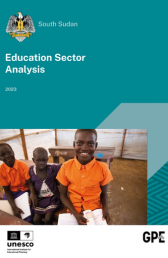
Langues
Anglais
Co-éditeur
South Sudan. Ministry of General Education and Instruction
Année
2017
Pages
140 p.
Country
Version en ligne
A propos de la publication
South Sudan's commitment to a stronger education system is reflected in its ambitious new five-year plan to improve service delivery nationwide. Embracing this challenge, the Ministry of General Education and Instruction (MoGEI) has developed a detailed plan which incorporates a transitional period, thereby allowing the state to rise above years of conflict and ensure its robust quality education system becomes a pillar of long-term peace, stability, and development. Education stakeholders in the global development and humanitarian community increasingly recognize the need to integrate conflict and disaster risk reduction into both analysis and planning. The renewed conflict in South Sudan which broke out in December 2013 exacerbated public policy challenges and further underlined the importance of crisis-sensitive planning – including risk analyses – for the development of an educational system sufficiently resilient to withstand future disruptions. Only by planning for unforeseen conflicts and natural disasters, and by integrating disaster risk reduction, can the South Sudanese education system remain functional in the face of shocks. In this context, South Sudan embarked in September 2015 on its second Education Sector Analysis (ESA). Representing much more than a simple update, the 2015 ESA is the first of its kind to incorporate crisis-sensitive analyses. Multiple education sector analyses, each of which constitutes a chapter of the report (i.e. on the global context, school enrolment and internal efficiency, cost and financing, as well as management and quality), were carried out using a crisis-sensitive lens. Equity analyses were also mainstreamed with a specific focus on gender and the regional state level, reflecting the decentralized nature of the education sector. These permit a better understanding of the challenges faced by the education sector, as well as its weaknesses and strengths.









